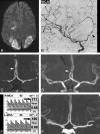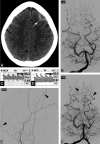Multimodal imaging of reversible cerebral vasoconstriction syndrome: a series of 6 cases
- PMID: 22422190
- PMCID: PMC7965494
- DOI: 10.3174/ajnr.A2964
Multimodal imaging of reversible cerebral vasoconstriction syndrome: a series of 6 cases
Abstract
RCVS is a clinical condition of recurrent severe headaches that may be associated with ischemic or hemorrhagic stroke and that is defined by the presence of segmental vasoconstriction in multiple cerebral arteries. The angiographic appearance resembles vasculitis, except that the abnormalities resolve during the course of several months. Because the treatment of RCVS differs from that for vasculitis, radiologists must understand the clinical and radiologic features so as to better guide imaging algorithms and facilitate diagnosis. We present a series of 6 cases of RCVS that highlight the imaging features across multiple modalities.
Figures






References
-
- Call GK, Fleming MC, Sealfon S, et al. . Reversible cerebral segmental vasoconstriction. Stroke 1988;19:1159–70 - PubMed
-
- Ducros A, Boukobza M, Porcher R, et al. . The clinical and radiological spectrum of reversible cerebral vasoconstriction syndrome: a prospective series of 67 patients. Brain 2007;130:3091–101 - PubMed
-
- Calabrese LH, Dodick DW, Schwedt TJ, et al. . Narrative review: reversible cerebral vasoconstriction syndromes. Ann Intern Med 2007;146:34–44 - PubMed
-
- Gerretsen P, Kern RZ. Reversible cerebral vasoconstriction syndrome or primary angiitis of the central nervous system? Can J Neurol Sci 2007;34:467–77 - PubMed
-
- Chen SP, Fuh JL, Wang SJ, et al. . Magnetic resonance angiography in reversible cerebral vasoconstriction syndromes. Ann Neurol 2010;67:648–56 - PubMed
Publication types
MeSH terms
Grants and funding
LinkOut - more resources
Full Text Sources
Medical
